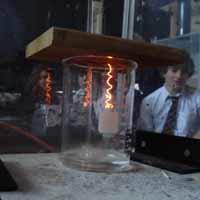Demonstrations designed to capture the student's imagination
Demonstrations to capture the student's imagination, by Adrian Guy of Blundell's School. In this issue: platinum-catalysed oxidation of ammonia
In this demonstration a coiled platinum wire catalyst is used to catalyse the oxidation of ammonia. Similar heterogeneous catalysts are used extensively in industry because they are robust at high temperatures, which allows for a wide range of operating conditions. An additional benefit is there are no extra steps required to separate the catalyst from the product. Typically, gaseous reactants enter a tubular reactor at one end, pass over a supported catalyst and the products are collected at the other end. Catalytic converters used to oxidise carbon monoxide and hydrocarbons, and reduce nitrous oxides in automobile exhaust fumes are based on the same simple design.1
Reactions on platinum
In this demonstration ammonia and oxygen are adsorbed onto the platinum surface in close proximity to each other, a reaction occurs, followed by desorption of the products. The atomic radius of platinum is 139×10-12 m, which is similar to the bond lengths of reactant gases - the oxygen-oxygen bond length is 121×10-12 m. The gaseous molecules are 'held' in position above corresponding metal atoms via weak van der Waals' forces.
For this demonstration you will need a length of platinum wire, which will cost approx. £40. However, owing to platinum's longevity, this wire will last for many years and is an excellent investment.

Kit
- 20cm of platinum wire;
- one-litre Pyrex beaker;
- 100ml of concentrated ammonia solution;
- piece of wood;
- drill;
- Bunsen burner;
- fume cupboard;
- 10cm glass rod;
- goggles;
- nitrile gloves.
Safety
All parts of the demonstration must be done in a fume cupboard. Wear goggles and gloves. Concentrated ammonia solution is corrosive and can burn the skin. Ammonia is toxic by inhalation and, like nitrogen oxides, irritating to the respiratory system and eyes. Dispose of all products down a sink in the fume cupboard with plenty of water.
Procedure
Drill two 15mm holes, 5cm apart, in a piece of wood big enough to cover the beaker. Working in a fume cupboard, pour 100ml of concentrated ammonia solution into the beaker and put the wooden 'lid' on top of the beaker. Coil the platinum wire around a pencil and then gently slide the coil from the pencil. Attach the coil to the glass rod, which will act as an anchor so that the coil can hang freely from the wooden lid. Heat the platinum in a roaring Bunsen burner to red heat and then rapidly hang the coil through a hole in the wooden lid into the flask. The platinum catalyst should glow red hot for several minutes, owing to the exothermic oxidation of ammonia to nitrogen oxide and water vapour:
4NH3 (g) + 5O2 (g) → 4NO(g) + 6H2 O(g)
Special tips
Use fresh, concentrated ammonia solution, otherwise the platinum catalyst seems to cool and stop working. Adjust the height at which the platinum coil hangs: too low and not enough oxygen will reach the coil; too high and not enough ammonia will be adsorbed onto the coil.
Teaching goals
This reaction is the first stage in the industrial preparation of nitric acid, which is discussed at GCSE and studied at A-level.2 This is an important industrial process because nitric acid is used in the production of fertilisers and explosives.
The demonstration is another excellent example of how a catalyst promotes a reaction by lowering its activation energy by providing an alternative reaction 'path', while the catalyst itself is not used up. By using the platinum catalyst the possible combustion of ammonia in oxygen is almost completely eliminated:
4NH3 (g) + 3O2 (g) → 2N2 (g) + 6H2 O(g)
and the otherwise slow oxidation of ammonia to nitrogen oxide dominates.
References
1. D. F. Shriver, P. W. Atkins and C. H. Langford, Inorganic chemistry, 4th edn, p558. Oxford: OUP, 1990.
2. D. F. Shriver, P. W. Atkins and C. H. Langford, ibid, p247.









1 Reader's comment